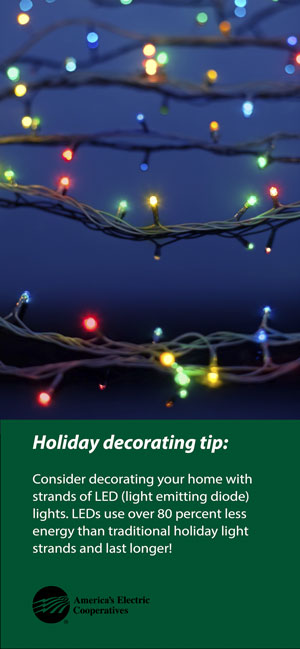For many of us, the best holidays involve home-cooked meals and wonderful aromas of turkey, dressing and baked goods wafting throughout the house. It means a busy kitchen and a bustling house full of family and friends. If this rings true for you, you still have an opportunity to save energy during the holidays despite the increased kitchen activity.
Cut carbs (carbon) painlessly
In addition to being the “heart of your home,” your kitchen could pump savings back into your wallet. According to the Department of Energy, cooking accounts for 4.5 percent of total energy use in U.S. homes. This number, combined with the energy use associated with refrigeration, dishwashing and water-heating, means that as much as 15 percent of the energy in the average American home is used in the kitchen. So, saving energy here can have a significant impact on your household budget.
For example, when preparing side dishes, baked goods, soups and such, consider using a small appliance like a slow-cooker, toaster oven, microwave or warming plate instead of your conventional oven or stovetop. These small appliances are smart, energy-saving alternatives, typically using about half the energy of a stove.
Seal in efficiency
When using your oven, don’t peek! Opening the oven door can lower the temperature by as much as 25 degrees and causes your stove to work harder (consuming more energy) to return to the set cooking temperature. If your recipe calls for baking the dish more than an hour, it is not necessary to preheat the oven. If your oven is electric, you can likely turn the oven off for the last five to 10 minutes of cooking and allow the residual heat to complete the job. Clean burners and reflectors increase efficiency and offer better heating, so don’t neglect this small but important task.
Just as keeping the oven door closed seals in efficiency and enables the stove to operate more economically, the same rules apply to the refrigerator and freezer. Keep the doors closed as much as possible so cold air doesn’t escape. However, leaving the door open for a longer period of time while you load groceries or remove items you need is more efficient than opening and closing it several times.
If you are entertaining a large group, you may be able to give your furnace a brief holiday. When your oven is working hard and you have a house full of guests, the heat from the stove and the guests will keep your house comfortable, enabling you to turn down the thermostat.
Clean up with energy savings
When it’s time to clean up, extend fellowship to the kitchen, and wash and dry dirty dishes by hand. This uses less energy than a dishwasher. However, don’t leave the water running continuously or you will waste energy. If you do use the dishwasher and rinse dishes before loading them, use cold water. Run the dishwasher with full loads only, and, if possible, use the energy-saving cycle. Note that dishwashers that have overnight or air-dry settings can save up to 10 percent of your dishwashing energy costs.
By adapting these efficient practices in your kitchen, energy savings will be one more thing to be thankful for this holiday season.
Anne Prince writes on consumer and cooperative affairs for the National Rural Electric Cooperative Association, the Arlington, Va.-based service arm of the nation’s 900-plus consumer-owned, not-for-profit electric cooperatives.


